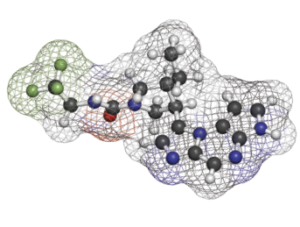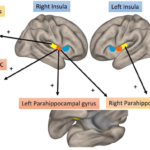
StudioMolekuul / shutterstock.com
As treatments for psoriatic arthritis (PsA) emerge, a clinical trial comparing the Janus kinase (JAK) inhibitor upadacitinib and the tumor necrosis factor (TNF) inhibitor adalimumab provided some new insights. Published earlier this year in The New England Journal of Medicine, the SELECT-PsA 1, double-blind, phase 3 trial found that a 30 mg dose of upadacitinib was superior to adalimumab—and a 15 mg dose of upadacitinib was non-inferior to adalimumab—but that more adverse events occurred with upadacitinib than with placebo.1
McInnes et al. also found the percentage of patients with PsA who had an ACR20 response at week 12 was significantly higher with the use of upadacitinib in 15 mg or 30 mg doses compared with placebo. All patients in the trial had an inadequate response to, or intolerable side effects with, nonbiologic disease-modifying anti-rheumatic drugs (DMARDs).
Adalimumab is already approved to treat PsA and rheumatoid arthritis. A 15 mg dose of upadacitinib was approved this year in the European Union for PsA, but has not yet been approved in the U.S. for PsA. And in September, the U.S. Food & Drug Administration (FDA) said it will require revisions to the Boxed Warning for JAK inhibitors to include information about the risks of serious heart-related events, lymphomas and lung cancer, blood clots and death.2 The FDA recommended reserving these medications for patients with an insufficient response, or intolerance, to one or more TNF blockers.
Study Details
The 24-week trial included 1,704 patients who received a drug or placebo. The global trial took place at 281 sites in 45 countries beginning in April 2017. Patients were assigned in a 1:1:1:1 ratio to receive either 15 mg or 30 mg of oral upadacitinib once daily, placebo or 40 mg of subcutaneous adalimumab every two weeks.
Patients in the trial had received a PsA diagnosis and had historical or current plaque psoriasis. They had three or more swollen joints and at least three tender joints. They also had one or more erosions on the hands or feet on radiography or a high-sensitivity C-reactive protein level higher than the lab-defined upper limit of the normal range.
Patients could receive non-steroidal anti-inflammatory drugs (NSAIDs), glucocorticoids and up to two nonbiologic DMARDs. Exclusion criteria included previous exposure to biologic therapies or JAK inhibitors.
Trial randomization was grouped by the extent of psoriasis (greater than 3% or less than 3% of the body surface area), current or non-use of one or more nonbiologic DMARDs, the presence or absence of dactylitis, and the presence or absence of enthesitis.
The primary end point was an ACR20 response (i.e., 20% or greater decrease in the number of tender or swollen joints and 20% or greater improvement in at least three of five other domains) at week 12 with upadacitinib compared with placebo. Secondary trial end points included change from baseline in the Health Assessment Questionnaire-Disability Index score at week 12, the percentage of patients with a decrease from baseline of at least 75% on the Psoriasis Area and Severity Index, and score changes on a variety of other assessments.

Dr. McInnes
AbbVie designed and sponsored the trial and provided the medications. AbbVie is the manufacturer of upadacitinib.
Among the 1,704 patients, 429 received the 15 mg dose of upadacitinib, 423 received the 30 mg dose of upadacitinib, 423 received the placebo and 429 received adalimumab. Ninety-one percent of patients completed the trial through week 24. Demographic characteristics were similar among all patient groups.
By week 12, an ACR20 response was observed in 70.6% of patients who received the 15 mg dose of upadacitinib, compared with 78.5% who received the 30 mg dose. An ACR20 response was observed by week 12 in 36.2% of those receiving placebo and in 65% of those in the adalimumab group.
The results showed that both the 15 mg and 30 mg doses were non-inferior to adalimumab in achieving an ACR20 response at week 12, and the 30 mg upadacitinib dose, but not the 15 mg dose, was superior to adalimumab.
Compared with placebo, the upadacitinib results were better for other aspects of PsA, including objective measures of psoriatic activity, physical function and fatigue. Because of the trial results, certain end points comparing 15 mg of upadacitinib and adalimumab could not be analyzed, the study researchers write.
McInnes et al. found some differences in the number of adverse and serious adverse events, with more frequent occurrences among those receiving the 30 mg upadacitinib dose. An upper respiratory tract infection was the most common adverse event. Serious infections occurred in 1.2% of patients taking the 15 mg upadacitinib dose, 2.6% taking the 30 mg dose, 0.9% taking placebo and 0.7% taking adalimumab.
Through week 24, other infections included a case of Candida urethritis with the 15 mg dose and one case of Pneumocystis jirovecii pneumonia and cytomegalovirus with the 30 mg dose. Herpes zoster occurred in four patients receiving the 15 mg dose of upadacitinib, five receiving the 30 mg dose, three receiving placebo, and none among those receiving adalimumab. One pulmonary embolism occurred with the 30 mg dose.
Cancer was diagnosed in one patient in the 15 mg upadacitinib group (i.e., neuroendocrine carcinoma), one in the placebo group (i.e., basal cell carcinoma) and three patients each in the 30 mg and adalimumab groups. In the 30 mg group, two patients were diagnosed with basal cell carcinoma and one with a malignant lung neoplasm. In the adalimumab group, one patient was diagnosed with colon cancer, one with ovarian cancer and one with uterine cancer.
The percentage of patients with adverse events involving hepatic disorders was 9.1% in the 15 mg upadacitinib group, 12.3% in the 30 mg group, 3.8% in the placebo group and 15.6% in the adalimumab group.
Anemia and lymphopenia occurred with similar incident rates with the 15 mg upadacitinib and placebo doses, but more frequently with the 30 mg dose. One patient had a grade 3 decrease in their hemoglobin level and another a grade 3 decrease in their platelet count after stopping the 30 mg dose of upadacitinib. The 30 mg group also had a higher frequency in grade 3 decreases in neutrophil and lymphocyte levels.
Going Forward
Longer and larger trials are needed to further analyze the effects and risks of upadacitinib and its effects compared with other drugs for PsA, McInnes et al. conclude.
The availability of more treatments for PsA is welcome considering that few new modalities existed until recently, says study author Iain B. McInnes, FRCP, PhD, professor of rheumatology and director of the Institute of Infection, Immunity and Inflammation at the University of Glasgow, Scotland, U.K. He points to several new pathways for PsA treatment, including JAKs, interleukin (IL) 17A, IL-12/23p40, IL-23p19, and phosphodiesterase 4, as well as TNF inhibitors.
“More [treatments] are on the way, which is very exciting,” Dr. McInnes says.
Vivian P. Bykerk, MD, FRCPC, professor of medicine and director of the Inflammatory Arthritis Center at the Hospital for Special Surgery, New York, sees the results as encouraging but also notes the 30 mg dose of upadacitinib was associated with more safety concerns and severe adverse advents. If this dose is approved for use in patients with PsA, providers will need to use its with caution, she notes, adding that upadacitinib 15 mg daily is a very good option for treatment of PsA, with a safety profile consistent with JAK inhibitors in other trials. If physicians choose JAKs for PsA, they should continue to monitor lab results for changes, Dr. Bykerk adds.
“The next steps require that we understand the best order of therapeutic intervention and which patient groups will benefit from the variety of modes of action now available to us,” Dr. McInnes says.
Vanessa Caceres is a medical writer in Bradenton, Fla.
References
- McInnes IB, Anderson JK, Magrey M, et al. Trial of upadacitinib and adalimumab for psoriatic arthritis. N Engl J Med. 2021 Apr 1;384(13):1227–1239.
- Losavio K. FDA Requires new Boxed Warnings on JAK inhibitors, places restrictions on use. 2021 Sep 1. The-Rheumatologist.org.



